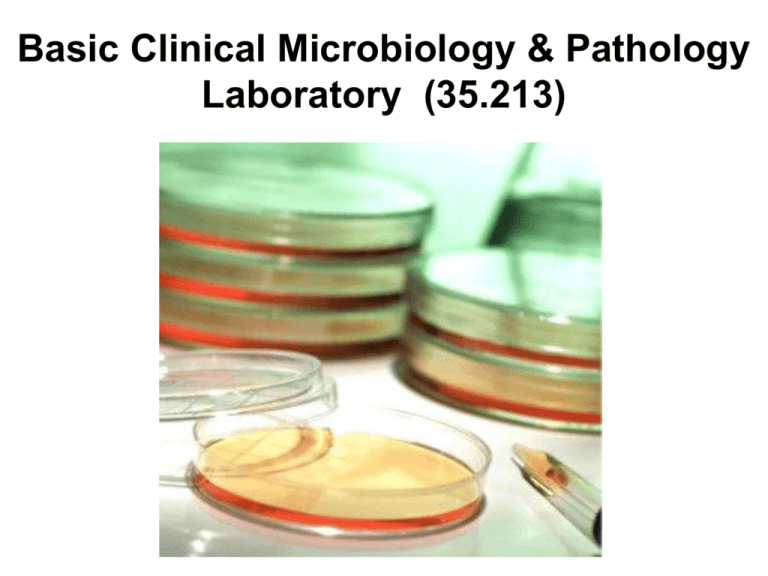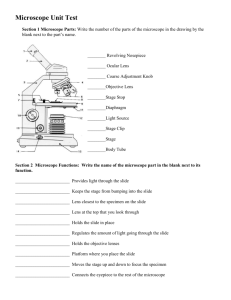Microbiology (BIO
advertisement

Basic Clinical Microbiology & Pathology Laboratory (35.213) Day Lab # JULY 7 1 JULY 8 2 JULY 9 3 JULY 13 4 JULY 14 JULY 15 JULY 16 JULY 20 JULY 21 JULY 22 JULY 23 JULY 27 JULY 28 JULY 29 JULY 30 AUG 3 AUG 4 AUG 5 AUG 6 AUG 10 AUG 11 AUG 12 LABORATORY EXERCISE Lab Introduction, Syllabus Review, Lab Guidelines, Lab Safety The Use and Care of the Microscope Preparation and Examination of Smears: Gram Stain Examination of Prepared Smears Preparation and Examination of Smears: Acid Fast Stain Examination of Prepared Smears SETUP: Aseptic Techniques and Isolation of Bacteria RESULTS: Aseptic Techniques and Isolation of Bacteria 5 6 7 8 9 10 11 12 PARASITOLOGY: Protozoa and Worms PRACTICAL LAB TEST #1: Labs 1 – 5 (6 pm) SET UP: Integumentary System RESULTS: Integumentary System SET UP: Respiratory System RESULTS: Respiratory System SET UP: Urogenital System RESULTS: Urogenital System PARASITOLOGY: Tick Identification PRACTICAL LAB TEST #2: Labs 6 – 9 (6 pm) SET UP: Gastrointestinal System RESULTS: Gastrointestinal System SET UP: Susceptibility Testing – KB and MIC RESULTS: Susceptibility Testing – KB and MIC FUNGI: Yeast and Moulds FUNGI: View prepared smears and Review PRACTICAL LAB TEST #3: Labs 10 – 12 (6pm) EMAIL: sarah_zimmerman@uml.edu sarah.k.zimmerman@lahey.org OFFICE HOURS: None. See me before or after class. LAB MANUAL: Custom UML LAB manual available in UML bookstore only Evaluation: 3 practical exams MY EXPECTATIONS • COME TO EVERY LAB PREPARED BY REVIEWING THE LAB EXPERIMENT IN YOUR MANUAL/PowerPoints • THERE IS NO MAKE-UP! MICROORGANISMS USED IN ALL EXPERIMENTS Many of the microorganisms we will use this semester will be Biosafety Level 1 (not shown to cause disease in humans) but several will be Biosafety Level 2 (can cause disease in humans). Because of this potential risk we ask that you treat ALL bacterial cultures as if they cause infection! GENERAL LAB RULES 1. BE ON TIME 2. ATTEND EVERY LAB 3. NO: CELL PHONES, TABLETS, LAPTOPS 4. NO: FOOD OR DRINK Lab Safety Guidelines 1. Absolutely NO food or drink. 2. Wear appropriate clothing (long pants) & shoes that cover your entire foot (no Flip-flops/sandals/open-toe shoes). 3. Wear a lab coat at all times. 4. Wash hands & clean off bench before and after lab. 5. Wear gloves & face shields when necessary. 6. Dispose of hazardous & nonhazardous materials appropriately. 7. Report any spills or accidents immediately. 8. Do not touch your eyes, nose, or mouth while in lab. LAB SAFETY NOTES What you should know: • • • What to do in case of a fire or biological hazard. Where safety equipment is located (fire alarm, extinguishers, eyewash stations, first aid kits, and exits). Where to properly dispose of waste (glass (SHARPS), biological, or chemical). PROPER TRASH DISPOSAL? FORMS & SIGNATURES USE AND CARE OF THE MICROSCOPE THE MICROSCOPE • A device used to magnify objects that are too small to be seen with the naked eye Simple Microscope – one lens (like a magnifying glass) Compound Microscope – two or more sets of lenses Simple Compound MICROSCOPE TERMS Specimen: the object that is being looked at on a slide Ocular lens: EYEPIECE Objective lens: lens closest to the specimen Condenser: lens that concentrates the light for better resolution of the specimen Iris diaphragm: controls the amount of light Rheostat: controls intensity of light Course adjustment: used for focusing with low power objective lens Fine adjustment: used for focusing with high power and oil immersion lens Parfocal – specimen will remain in focus as you change the objective lenses Resolution – the ability of the lenses to reveal fine detail How does a microscope work? PARTS OF A COMPOUND MICROSCOPE MAGNIFICATION • Compound microscopes have 3-4 objective lenses: – Scanning (4x), low power (10x), high power dry)(high-dry) (40x), and oil immersion (100x) • The ocular lens (eyepiece) has a magnification of 10x. TOTAL MAGNIFICATION DETERMINATION COMPOUND MICROSCOPE MAGNIFICATION – OIL (100X) • OIL IMMERSION: PLACE A DROP OF IMMERSION OIL ON THE SLIDE BEFORE THE 100X OBJECTIVE LENS IS USED. THIS DECREASES THE BENDING OF THE LIGHT RAYS (REFRACTION) • NOTE: OIL MUST BE WIPED OFF THIS OBJECTIVE AND THE SLIDE IN ORDER TO USE ANOTHER OBJECTIVE TIPS FOR SUCCESS 1. HANDLE THE MICROSCOPE WITH CARE (BOTH HANDS). 2. CLEAN IT THOROUGHLY WITH ONLY LENS PAPER AT THE END OF EACH CLASS. 3. DO NOT FORCE ANY OF THE MICROSCOPE’S ADJUSTMENTS. 4. DO NOT DIS-ASSEMBLE ANYTHING – SEE ME IF YOU HAVE ANY PROBLEMS. 5. MICROSCOPE SLIDES SHOULD BE PLACED WITH THE COVERSLIP UP…CLOSEST TO THE OBJECTIVE. TIPS FOR SUCCESS 6. ALWAYS BEGIN WITH THE 4X OBJECTIVE AND WORK UP TO HIGHER MAGNIFICATION. 4X 10X 40X ADD OIL100X 7. ALWAYS PLACE YOUR SPECIMEN IN THE CENTER OF YOUR FIELD OF VIEW BEFORE SWITCHING TO THE NEXT HIGHER OBJECTIVE. 8. FOCUSING PROBLEM – MOVE THE SLIDE TO THE EDGE OF THE COVERSLIP AND FOCUS ON THAT FIRST. 9. OBJECTS VIEW WILL GET BIGGER AS THE MAGNIFICATION INCREASES. BASIC BACTERIAL AND YEAST MORPHOLOGIES WHITE AND RED BLOOD CELLS





